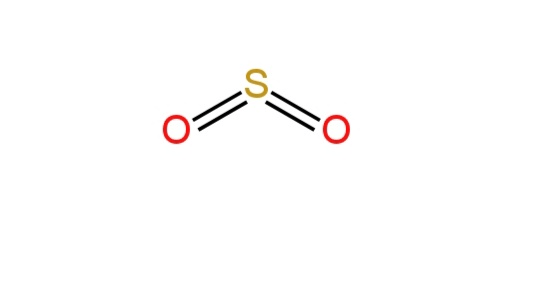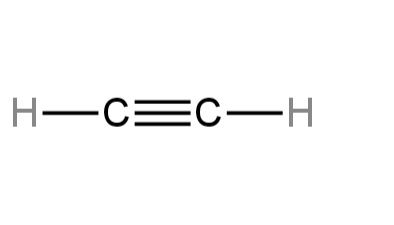
Which of the following compounds doesn't have a linear structure
A. Carbon dioxide
B. Sulfur dioxide
C. Beryllium chloride
D. Ethylene
Answer
219.9k+ views
Hint: Linear compounds undergo sp hybridization and remain at an angle of \[180^o\] with each other. When multiple bonds are involved in a molecule, only one electron group is considered for multiple bonds for hybridization in these types of compounds.
Complete step by step solution:A. Carbon dioxide
Carbon is the central atom. It has four valence electrons. Each oxygen atom is doubly bonded to the carbon atom.
There are two sigma bonds and two pi-bonds on C.
So, there will be sp hybridization.
So, it has a linear structure.
So, A is incorrect.
B. Sulfur dioxide
Sulfur is the central atom. It has six electrons in its valence shell.
Each oxygen atom is doubly bonded to the carbon atom.
There are two bond pairs and one lone pair on S.
So, there will be \[sp^2\] hybridization.
So, it has a bent structure.

Structure: Structure of sulfur dioxide
So, B is correct.
C. Beryllium chloride
Be is the central atom. It has two valence electrons.
Each chlorine atom is bonded to the Be atom through a sigma bond.
There are two bond pairs.
So, there will be sp hybridization.
So, it has a linear structure.
So, C is incorrect.
D. Ethylene
In this, each carbon atom is bound with one hydrogen atom and the two carbon atoms are joined together. The bond between the carbon and carbon atom is a triple bond.
Considering the triple bond as one electron group, we see that there are two electron groups on carbon.
Here the hybridization will be sp.
The structure of ethylene is provided below:

So, D is incorrect.
Sulfur dioxide has a bent structure.
So, option B is correct.
Note: Sulfur dioxide is utilized in numerous industries. It's utilized to manufacture sulfuric acid, paper, and food preservatives. It works as a bleaching agent to pull out the excess chlorine and as a disinfectant. In a cold storage plant, it behaves as a refrigerant.
Complete step by step solution:A. Carbon dioxide
Carbon is the central atom. It has four valence electrons. Each oxygen atom is doubly bonded to the carbon atom.
There are two sigma bonds and two pi-bonds on C.
So, there will be sp hybridization.
So, it has a linear structure.
So, A is incorrect.
B. Sulfur dioxide
Sulfur is the central atom. It has six electrons in its valence shell.
Each oxygen atom is doubly bonded to the carbon atom.
There are two bond pairs and one lone pair on S.
So, there will be \[sp^2\] hybridization.
So, it has a bent structure.

Structure: Structure of sulfur dioxide
So, B is correct.
C. Beryllium chloride
Be is the central atom. It has two valence electrons.
Each chlorine atom is bonded to the Be atom through a sigma bond.
There are two bond pairs.
So, there will be sp hybridization.
So, it has a linear structure.
So, C is incorrect.
D. Ethylene
In this, each carbon atom is bound with one hydrogen atom and the two carbon atoms are joined together. The bond between the carbon and carbon atom is a triple bond.
Considering the triple bond as one electron group, we see that there are two electron groups on carbon.
Here the hybridization will be sp.
The structure of ethylene is provided below:

So, D is incorrect.
Sulfur dioxide has a bent structure.
So, option B is correct.
Note: Sulfur dioxide is utilized in numerous industries. It's utilized to manufacture sulfuric acid, paper, and food preservatives. It works as a bleaching agent to pull out the excess chlorine and as a disinfectant. In a cold storage plant, it behaves as a refrigerant.
Recently Updated Pages
Electricity and Magnetism Explained: Key Concepts & Applications

JEE Energetics Important Concepts and Tips for Exam Preparation

JEE Isolation, Preparation and Properties of Non-metals Important Concepts and Tips for Exam Preparation

JEE Main 2021 July 25 Shift 1 Question Paper with Answer Key

JEE Main 2021 July 22 Shift 2 Question Paper with Answer Key

States of Matter Chapter For JEE Main Chemistry

Trending doubts
JEE Main 2026: Application Form Open, Exam Dates, Syllabus, Eligibility & Question Papers

Derivation of Equation of Trajectory Explained for Students

Hybridisation in Chemistry – Concept, Types & Applications

Understanding the Angle of Deviation in a Prism

How to Convert a Galvanometer into an Ammeter or Voltmeter

Understanding Centrifugal Force in Physics

Other Pages
NCERT Solutions For Class 11 Chemistry Chapter 7 Redox Reaction

JEE Advanced Marks vs Ranks 2025: Understanding Category-wise Qualifying Marks and Previous Year Cut-offs

Hydrocarbons Class 11 Chemistry Chapter 9 CBSE Notes - 2025-26

Thermodynamics Class 11 Chemistry Chapter 5 CBSE Notes - 2025-26

NCERT Solutions ForClass 11 Chemistry Chapter Chapter 5 Thermodynamics

Equilibrium Class 11 Chemistry Chapter 6 CBSE Notes - 2025-26




